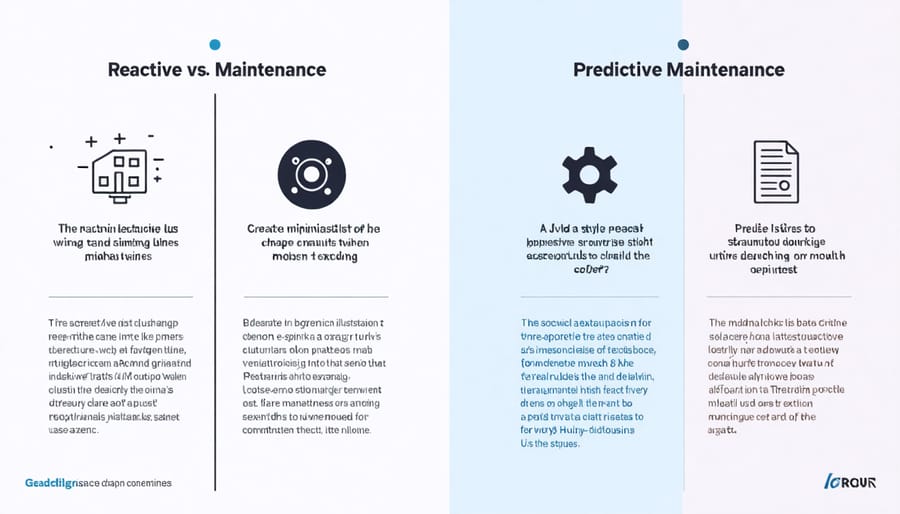Transform your maintenance operations with AI-powered predictive maintenance and IoT sensors that reduce equipment downtime by up to 50% while cutting maintenance costs by 30%. Today’s industrial facilities face unprecedented pressure to maximize asset performance and minimize operational disruptions. IoT-enabled predictive maintenance revolutionizes traditional approaches by detecting potential failures weeks before they occur, analyzing real-time equipment data through advanced algorithms, and providing actionable insights for maintenance teams.
Leading manufacturers implementing IoT-based predictive maintenance systems report ROI exceeding 200% within the first year through prevented breakdowns, optimized maintenance schedules, and extended equipment lifecycles. These smart systems combine vibration analysis, thermal imaging, and performance metrics to create a comprehensive view of asset health, enabling facility managers to shift from reactive repairs to strategic maintenance planning.
By integrating IoT sensors with existing building management systems, organizations gain unprecedented visibility into their operations while establishing data-driven maintenance protocols that significantly reduce operational risks and capital expenditure.
The Evolution of Building Maintenance Systems
From Reactive to Predictive: A Paradigm Shift
Traditional maintenance approaches have long relied on reactive measures, where repairs are conducted only after equipment failure, or preventive schedules based on fixed time intervals. This methodology often results in unnecessary downtime, increased repair costs, and reduced equipment lifespan. The shift towards predictive maintenance represents a fundamental transformation in how we approach asset management.
IoT-enabled predictive maintenance leverages real-time data collection and analysis to identify potential issues before they escalate into critical failures. Through a network of sensors monitoring vibration, temperature, pressure, and other vital parameters, maintenance teams can now detect subtle changes in equipment performance that might indicate emerging problems.
This paradigm shift has revolutionized maintenance strategies across the construction industry. Instead of responding to failures, organizations can now plan interventions based on actual equipment condition and performance data. The result is a more efficient maintenance program that optimizes resource allocation, reduces unexpected downtime, and extends asset life cycles.
The transition from reactive to predictive maintenance typically delivers 30-50% reduction in maintenance costs and up to 70% decrease in equipment breakdowns, making it a crucial investment for forward-thinking construction companies.

The Cost Impact of Smart Maintenance
The implementation of IoT-driven predictive maintenance delivers substantial cost savings across multiple dimensions. Industry data shows that organizations can reduce maintenance costs by 25-30% while decreasing equipment downtime by up to 45%. Similar to smart building energy management systems, predictive maintenance solutions typically achieve ROI within 12-24 months of deployment.
A recent study of commercial facilities revealed that predictive maintenance reduces unexpected breakdowns by 70%, extending equipment life by 20-25%. This translates to significant savings in replacement costs and emergency repair fees. Labor efficiency also improves markedly, with maintenance teams spending 35% less time on routine inspections and reactive repairs.
For a typical 50,000-square-foot commercial building, predictive maintenance can generate annual savings of $30,000-45,000 through reduced energy consumption, optimized maintenance scheduling, and prevented equipment failures. These figures don’t include indirect benefits such as improved tenant satisfaction and reduced insurance premiums due to better risk management.
IoT Sensor Networks: The Foundation of Smart Maintenance

Critical Sensor Types and Their Applications
Modern predictive maintenance systems rely on sophisticated IoT sensor networks that continuously monitor various building components and systems. Temperature sensors track HVAC performance and detect potential overheating issues in mechanical equipment. Vibration sensors monitor the operational health of rotating machinery, such as pumps, motors, and elevator systems, identifying unusual patterns that might indicate impending failure.
Pressure sensors play a crucial role in monitoring hydraulic systems, plumbing networks, and HVAC operations, while humidity sensors help prevent moisture-related issues that could compromise building integrity. Power consumption sensors track electrical systems’ efficiency and identify energy waste or potential electrical failures.
Acoustic sensors detect unusual sounds in mechanical systems, offering early warning of bearing wear or misalignment. Air quality sensors monitor ventilation effectiveness and detect potentially harmful contaminants. Load cells and strain gauges assess structural integrity by measuring changes in weight distribution and material stress.
These sensors work in concert, providing real-time data that building management systems analyze to predict maintenance needs. When integrated with machine learning algorithms, this sensor ecosystem enables precise forecasting of equipment failures and optimal maintenance scheduling, significantly reducing downtime and maintenance costs.
Data Collection and Integration Strategies
In modern building management systems, data collection begins with strategically placed IoT sensors that monitor various parameters including temperature, humidity, vibration, energy consumption, and equipment performance metrics. These sensors continuously gather real-time data through wireless protocols such as WiFi, Bluetooth Low Energy (BLE), or LoRaWAN, depending on the building’s infrastructure requirements.
The integration process typically follows a three-tier architecture. At the field level, sensors transmit raw data to local gateways or edge devices, which perform initial data processing and filtering. This preprocessed data is then securely transmitted to a central building management platform through APIs or dedicated protocols like BACnet or Modbus.
Cloud-based integration platforms play a crucial role in data aggregation, offering scalable storage and processing capabilities. These platforms implement data normalization techniques to ensure consistency across different sensor types and manufacturers. Advanced systems employ edge computing to reduce latency and bandwidth usage, processing critical data locally before transmission.
Data quality assurance is maintained through automated validation processes that identify anomalies and sensor malfunctions. Modern systems also incorporate data redundancy and backup mechanisms to prevent information loss. The integrated data is then structured into standardized formats, enabling seamless analysis by predictive maintenance algorithms and visualization tools.
To ensure system reliability, many facilities implement real-time monitoring dashboards that display sensor health status and data flow metrics, allowing facility managers to quickly identify and address any collection or integration issues.
AI-Powered Analytics: Making Sense of Building Data
Machine Learning Models in Fault Detection
Machine learning models serve as the analytical backbone of IoT-based predictive maintenance systems, employing sophisticated algorithms to detect patterns and anomalies in equipment performance data. These models utilize various AI techniques, including supervised learning for known fault patterns and unsupervised learning for detecting unexpected anomalies.
Common algorithms deployed in fault detection include Random Forests, which excel at classifying multiple failure modes, and Support Vector Machines (SVMs), which effectively identify subtle deviations from normal operating conditions. Deep Learning Neural Networks have proven particularly valuable for complex industrial equipment, capable of processing vast amounts of sensor data to predict potential failures with remarkable accuracy.
When integrated with digital twins technology, these models become even more powerful, enabling real-time comparison between actual equipment performance and ideal operating parameters. This combination allows for more precise fault detection and reduced false positives.
Recent developments in transfer learning have made these models more adaptable across different equipment types, while ensemble methods combine multiple algorithms to achieve higher prediction accuracy. The key to successful implementation lies in proper model training with high-quality historical data and continuous refinement based on new operational data and maintenance outcomes.
Real-time Monitoring and Alert Systems
Real-time monitoring and alert systems represent the cornerstone of modern predictive maintenance strategies, leveraging IoT sensors and AI algorithms to provide immediate insights into equipment performance. These systems continuously collect and analyze data from multiple sensor points, including vibration patterns, temperature fluctuations, pressure levels, and electrical consumption metrics.
The AI-powered monitoring systems establish baseline performance parameters for each piece of equipment and detect deviations that could indicate potential failures. When anomalies are detected, the system automatically generates alerts based on predetermined thresholds, allowing maintenance teams to respond proactively before minor issues escalate into major problems.
Advanced alert systems employ machine learning algorithms to categorize maintenance issues by severity and urgency. This prioritization helps facility managers allocate resources efficiently and schedule maintenance activities strategically. For instance, a critical bearing failure alert would trigger immediate action, while a minor efficiency decrease might be scheduled for the next maintenance window.
These systems also integrate with maintenance management software to automatically generate work orders, assign tasks to appropriate personnel, and maintain detailed maintenance histories. The real-time nature of these alerts significantly reduces response times and minimizes equipment downtime, with some organizations reporting up to 30% reduction in unexpected failures after implementation.
For optimal effectiveness, alert systems can be customized to specific industry requirements and equipment types, ensuring that maintenance teams receive relevant, actionable information rather than being overwhelmed with unnecessary notifications.

Implementation Case Study: The Gherkin Building
System Integration Challenges and Solutions
Implementing IoT-based predictive maintenance systems presents several significant integration challenges that organizations must address for successful deployment. Legacy systems often operate on outdated protocols, making seamless communication with modern IoT sensors particularly challenging. Based on industry case studies, successful implementations typically require establishing middleware solutions that can translate between different communication protocols.
Data standardization emerges as another critical challenge, especially when dealing with multiple sensor types and manufacturers. Organizations have found success by implementing standardized data models and establishing clear data governance frameworks before deployment. This ensures consistent interpretation of sensor data across different maintenance systems and platforms.
Security concerns also present significant obstacles, particularly when integrating IoT devices into existing building management systems. Best practices include implementing end-to-end encryption, regular security audits, and maintaining isolated networks for critical systems. Additionally, organizations must address bandwidth limitations and network reliability issues, often solved through edge computing solutions that process data locally before transmission.
Staff training and change management prove equally important. Successful implementations typically include comprehensive training programs and phased rollouts to ensure maintenance teams can effectively utilize new systems. Organizations that have overcome these challenges report significant improvements in maintenance efficiency, with some achieving up to 30% reduction in unexpected equipment failures.
Measurable Results and Benefits
Organizations implementing IoT-based predictive maintenance consistently report significant improvements across multiple operational metrics. Studies show a 20-30% reduction in maintenance costs, while equipment downtime decreases by up to 45% compared to traditional maintenance approaches. Major manufacturing facilities have documented 50% fewer unexpected failures and a 25% increase in machine lifetime.
The financial impact is equally compelling, with ROI typically ranging from 10x to 30x within the first year of implementation. One Fortune 500 construction equipment manufacturer reported annual savings of $5.3 million after deploying IoT sensors across their production facilities. Energy consumption typically decreases by 15-20% through optimized equipment performance and early detection of inefficiencies.
Workforce productivity sees marked improvement, with maintenance teams reporting 35% more efficient scheduling and a 40% reduction in emergency repairs. Safety incidents related to equipment failure decrease by an average of 65%, while compliance rates improve by 30%.
Real-time monitoring capabilities enable organizations to achieve 99.9% accuracy in predicting equipment failures up to three months in advance. This predictive capability translates to an average 20% extension of asset lifecycle and a 25% reduction in spare parts inventory costs. Moreover, facilities utilizing IoT-based predictive maintenance report a 15% improvement in overall equipment effectiveness (OEE) and a 30% reduction in maintenance-related production losses.
Future Trends and Recommendations
The future of IoT-enabled predictive maintenance is rapidly evolving, with several emerging technologies poised to transform the construction industry. Edge computing is becoming increasingly crucial, allowing for faster data processing and reduced latency in maintenance decisions. Industry experts predict that by 2025, approximately 75% of enterprise-generated data will be processed at the edge, significantly improving response times for critical maintenance alerts.
Artificial Intelligence and Machine Learning algorithms are becoming more sophisticated, enabling more accurate failure predictions and reduced false positives. The integration of Digital Twins with IoT systems is emerging as a powerful tool for maintenance planning, providing virtual representations of physical assets that can be monitored and analyzed in real-time.
To successfully implement these advancing technologies, organizations should focus on several key recommendations:
1. Develop a clear digital transformation strategy that includes IoT integration
2. Invest in cybersecurity measures to protect connected systems
3. Ensure proper staff training and change management procedures
4. Establish standardized data collection and analysis protocols
5. Create scalable infrastructure that can accommodate future technological advances
The adoption of 5G networks will further enhance IoT capabilities, enabling more devices to be connected simultaneously while maintaining high-speed data transmission. Additionally, the emergence of self-healing materials and smart sensors will revolutionize how we approach maintenance, potentially reducing the need for human intervention in routine inspections and minor repairs.
IoT and predictive maintenance represent a transformative approach to building management that can no longer be ignored. By implementing IoT sensors, establishing robust data collection systems, and leveraging predictive analytics, facility managers can significantly reduce maintenance costs while extending equipment life. The key to success lies in starting small, focusing on critical assets first, and gradually expanding the system based on proven results. Remember to prioritize cybersecurity measures, ensure proper staff training, and maintain regular system updates. For optimal results, establish clear KPIs, document maintenance improvements, and continuously refine your predictive maintenance strategy based on collected data. Moving forward, consider partnering with experienced IoT solution providers and investing in scalable systems that can grow with your facility’s needs. The future of building maintenance is data-driven, and early adopters will gain a significant competitive advantage in operational efficiency and cost management.

